Auschwitz - Birkenau German Nazi Concentration and Extermination Camp (1940-1945): The former Nazi concentration camp Auschwitz - Birkenau is located near the town Oświęcim in Poland, about 60 km of Kraków. Auschwitz was one of the concentration camp under Nazi occupation, initially a concentration camp for Poles and later for Russian prisoners of war. Auschwitz consists of three main camps: Auschwitz I, Auschwitz - Birkenau and the work camp Auschwitz-Monowitz. The concentration- and extermination camps were designed and built by Nazi Germany. Between 1942-1945, Auschwitz became a mass extermination camp. About 1.5 million people were murdered in Auschwitz - Birkenau, most of them were Jews. Roma, Sinti and prisoners of several European nationalities were also murdered in Auschwitz - Birkenau. About 147,000 Polish political prisoners were deported to Auschwitz, of whom 74,000 did not survive. Soviet troops liberated Auschwitz on 27 January 1945. Rudolf Höss was the longest serving Nazi commandant of Auschwitz. After WWII, the Supreme National Tribunal in Warsaw tried Höss for war crimes. He was sentenced to death by hanging in april 1947. Auschwitz - Birkenau is now a monument in memory of the victims. Probably, the most famous victim of the Holocaust, also known as the Shoah, the mass murder of the Jews by the nazi's, was Anne Frank. Auschwitz - Birkenau German Nazi Concentration and Extermination Camp (1940-1945) gained the status a UNESCO World Heritage in 1979. Work of art: Anne Frank
www.werelderfgoedfotos.nl © Copyright World Heritage Photos
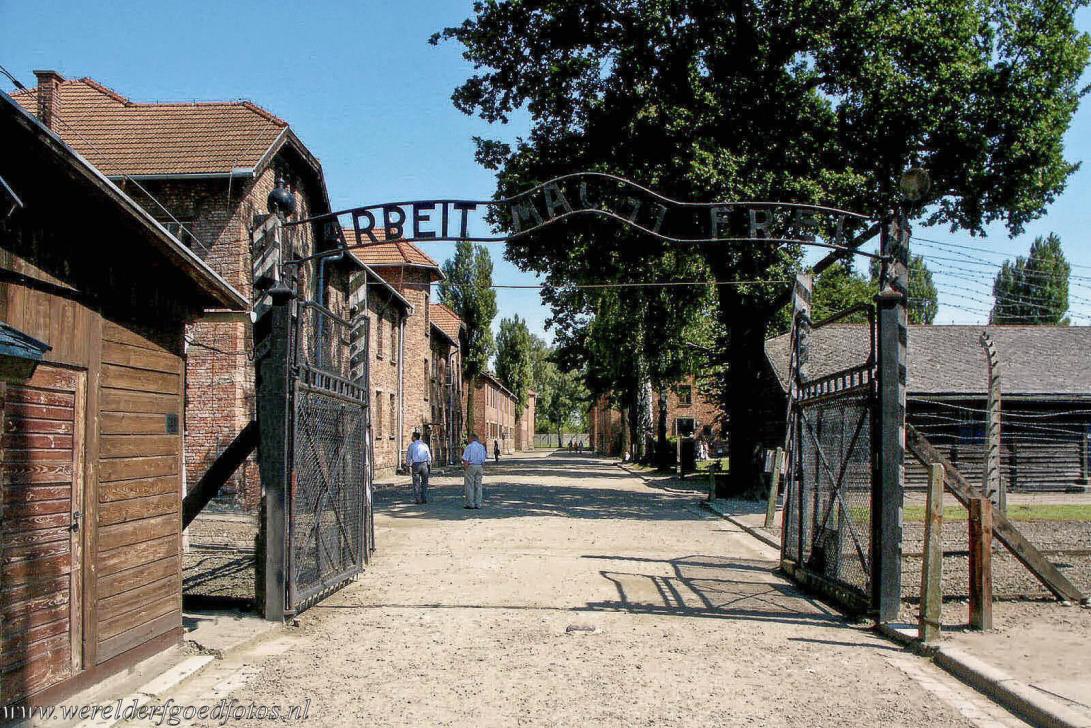
Auschwitz - Birkenau German Nazi Concentration and Extermination Camp (1940-1945): The main gate with the slogan 'Arbeit macht Frei' (Work sets you free) of Auschwitz I. The sign was erected by order of Rudolf Höss, the longest serving Nazi commandant of Auschwitz. The sign was created by prisoners in 1940, they turned the letter B upside down, probably as an act of resistance.

Auschwitz - Birkenau German Nazi Concentration and Extermination Camp (1940-1945): The main gate with the slogan 'Arbeit macht Frei' (Work sets you free) of Auschwitz I. The sign was erected by order of Rudolf Höss, the longest serving Nazi commandant of Auschwitz. The sign was created by prisoners in 1940, they turned the letter B upside down, probably as an act of resistance.
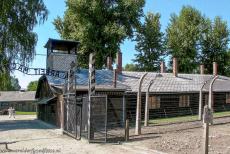
Auschwitz - Birkenau German Nazi Concentration and Extermination Camp (1940-1945): One of the watchtowers next to the main gate of Auschwitz I. On the left hand side the gate bearing the Nazi slogan: Arbeit macht Frei (Work sets you free). The slogan appeared over the gate of a large number of Nazi concentration and extermination camps, the concentration and extermination camps were designed and built by Nazi Germany.
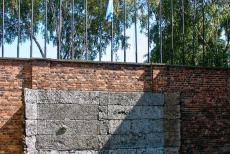
Auschwitz - Birkenau German Nazi Concentration and Extermination Camp (1940-1945): A reconstruction of the execution wall, also known as the Black Wall. According to the Auschwitz Museum 20,000 people were executed at the Black Wall, mainly Polish resistance fighters. The Black Wall is situated between block 10 and block 11 at Auschwitz I. About 147,000 Poles were deported to Auschwitz, of whom 74,000 died.
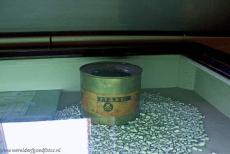
Auschwitz - Birkenau German Nazi Concentration and Extermination Camp (1940-1945): An empty poison gas canister of Zyklon B found by the Allies at Auschwitz - Birkenau. Zyklon B was the trade name of a pesticide used by Nazi Germany against human beings in the gas chambers of Auschwitz - Birkenau and many other extermination camps such as Majdanek, Treblinka and Sobibor. Approximately 1.5 million people were murdered in Auschwitz - Birkenau, mostly Jews.
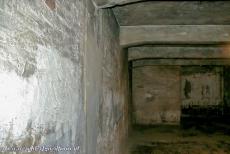
Auschwitz - Birkenau German Nazi Concentration and Extermination Camp (1940-1945): The gas chamber in Auschwitz I is preserved in its original state. About 1.5 million people were killed in Auschwitz and Birkenau, mostly Jews, the most of them were killed in the gas chambers, others died from diseases and starvation. During World War II, about 6 million Jews were murdered by the Nazis. Also hundreds of thousands of Roma and Sinti were murdered by the Nazis.
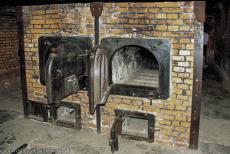
Auschwitz - Birkenau German Nazi Concentration and Extermination Camp (1940-1945): The ovens in the crematorium of Auschwitz I. The 52 ovens in the crematoria of Auschwitz - Birkenau cremated the bodies of those who died in the concentration camp. About 4,500 corpses per day were cremated. Not only Jews were murdered in Auschwitz I and Birkenau, but also Roma, Sinti, prisoners of war, Polish victims and resistance fighters of several European nationalities.
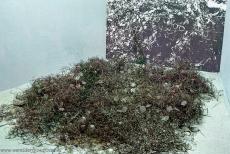
Auschwitz - Birkenau German Nazi Concentration and Extermination Camp (1940-1945): The eyeglasses taken from the victims of Auschwitz - Birkenau before they were sent into the gas chamber. Between 1942-1945, Auschwitz - Birkenau became a mass extermination camp. Most people were immediately killed in the gas chambers, but political prisoners of several European nationalities were forced to carry out hard labor, they received a tattoo on their inner forearm.
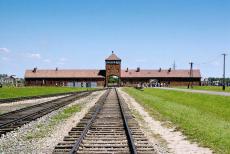
Auschwitz - Birkenau German Nazi Concentration and Extermination Camp (1940-1945): Behind the 'Gate of Death' lies the unloading ramp of Auschwitz - Birkenau. During World War II, more than 6 million Jews were murdered by the Nazi's. Another 5 million people were also murdered, among them Roma, Sinti, gay people, disabled people, priests and resistance fighters from all of Nazi occupied Europe. During WWII, over 25 million soldiers and 41 million civilians were killed.
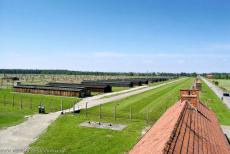
Auschwitz - Birkenau: The barbed wire fences and buildings of sector BIIa. The BIIb sector was a 'model camp, used for Nazi propaganda, the prisoners were allowed to keep their own clothing, their belongings and hair. This 'model camp' was liquidated in July 1944, most of the prisoners were sent into the gas chambers. The original wooden barracks of Auschwitz - Birkenau, except one, were destroyed after World War II.
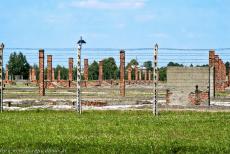
Auschwitz - Birkenau German Nazi Concentration and Extermination Camp (1940-1945): The brick chimneys are all that remain of the wooden buildings of Auschwitz - Birkenau. Anne Frank was first deported to Auschwitz - Birkenau in 1944 and later transferred to the concentration camp Bergen-Belsen where she died in February 1945. After her death, Anne Frank has become world famous because of a diary she wrote while in hiding at the Prinsengracht in Amsterdam.
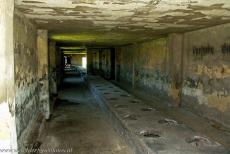
Auschwitz - Birkenau: The latrines were very primitive facilities. The sanitary conditions for the prisoners at Nazi concentration camp Auschwitz - Birkenau were extremely poor. The latrines were just a series of holes in a raw concrete bench. Auschwitz consists of three main camps: the death camp Auschwitz I, extermination camp Auschwitz II, also known as Auschwitz - Birkenau, and the labor camp Auschwitz III, known as Auschwitz - Monowitz.
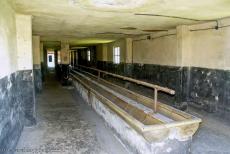
Auschwitz - Birkenau German Nazi Concentration and Extermination Camp (1940-1945): The washrooms, the sanitary conditions for prisoners at Auschwitz - Birkenau were extremely poor, there was a constant lack of water and if available, the water was not clean. During World War II, Auschwitz I was initially a concentration camp for Poles and later for Russian prisoners of war. The former concentration camp Auschwitz I is situated close to the town of Oświęcim in Poland.
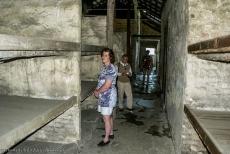
Auschwitz - Birkenau: Inside one of the remaining prisoner barracks. The prisoner barracks were overcrowded, very dirty and swarmed with insects and rodents, responsible for the spread of a number of infectious diseases. The concentration and axtermination camp Auschwitz - Birkenau was built in Poland under Nazi occupation. The Auschwitz concentration camp complex was the largest of all Nazi death camps.
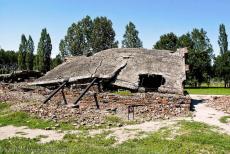
The ruins of crematorium II at the concentration and extermination camp Auschwitz - Birkenau. The crematories and gas chambers were destroyed by the SS a few days before the Auschwitz concentration camp complex was liberated by Soviet troops. In human history, Auschwitz was the site of the largest mass murder in a single location. Auschwitz - Birkenau, the German Nazi Concentration and Extermination Camp was declared a UNESCO World Heritage in 1979.
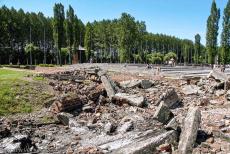
The ruins of Krema II and the gas chamber at Auschwitz - Birkenau. The crematoria were called Krema. The Soviet Red Army liberated Auschwitz on 27 January 1945. The crematories and gas chambers were destroyed by the SS, just a few days before the concentration camp Auschwitz - Birkenau was liberated by the Soviets. The Soviet soldiers found 7,000 survivors suffering from starvation and disease, they also found numerous unburied corpses, bones and human ashes.
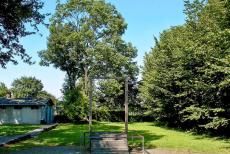
Auschwitz - Birkenau German Nazi Concentration and Extermination Camp (1940-1945): The gallows where the camp commandant Rudolf Höss was executed on 16 april 1947. The Nazi Rudolf Höss was tried and convicted of war crimes. He was sentenced to death by hanging on 2 april 1947. The gallows was constructed specifically for his execution, next to the gas chamber and crematory and not far from his former villa in Auschwitz I.
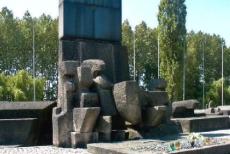
Auschwitz - Birkenau German Nazi Concentration and Extermination Camp (1940-1945): The Auschwitz - Birkenau International Monument was erected in 1967. The monument is situated in Auschwitz II, also known as Auschwitz - Birkenau. The monument is surrounded by more than twenty memorial plaques, each bearing the same inscription in a different language, including Hebrew and Yiddish.
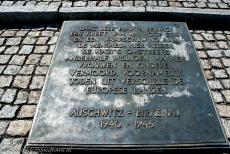
Auschwitz - Birkenau: Dutch memorial tablet. Approximately 1.5 million people were murdered in Auschwitz - Birkenau, mostly Jews. About 6 million Jews were murdered by the Nazis overall. The former Nazi concentration- and extermination camp Auschwitz - Birkenau is nowadays a monument to the martyrdom of the Jews, the people of Poland and other nations. Auschwitz - Birkenau became a UNESCO World Heritage in 1979.
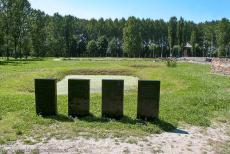
Auschwitz - Birkenau German Nazi Concentration and Extermination Camp (1940-1945): Ash Pond Memorial, four black memorial stones at one of the ash ponds of Auschwitz - Birkenau. The black stones mark the spot with the ashes of victims of the Nazi regime. Each of the four crematoria of Auschwitz - Birkenau had its own pond, that the Nazis used to dump the ashes of their cremated victims.
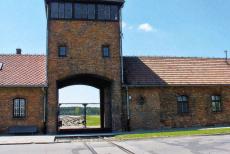
The 'Gate of Death' of Auschwitz - Birkenau. Since the liberation of the Nazi concentration and extermination camp on 27 January 1945, Auschwitz - Birkenau is almost left intact in its original state, it is a memorial site in remembrance to the victims of the Nazi regime. The Auschwitz - Birkenau German Nazi Concentration and Extermination Camp (1940-1945) was inscribed on the UNESCO World Heritage List in 1979.
